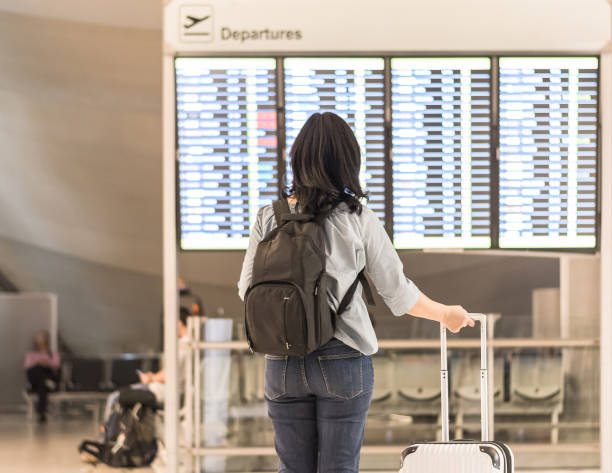TIPS FOR FLYING MORE ECO-FRIENDLY | Flightlayaway
As everyone becomes more environmentally conscious, flying in an eco-friendly way has become much more of a hot topic, with people wondering what exactly can be done to reduce your carbon footprint and plastic waste when flying. So, Flightlayaway has put together the best tricks and tips to help reduce the environmental impact of your flights.
How to fly more eco-friendly
1. Choose an eco-friendly airline
Most of the emissions and waste that
come from flying are set by the airline itself, meaning you aren’t in control
of the majority of the environmental damage of your flying. However, you can
minimize your environmental footprint by doing your research and choosing an
eco-friendly airline. Not only can you check out our page for the most
eco-friendly airlines, but you can also do additional research by checking what
aircraft you will be flying on. You’ll find that newer models are more
fuel-efficient, with aircraft such as the Boeing 787 Dreamliner and the Airbus
A350 leading the way in the industry. You can do even more research using tools
such as the ‘Matrix Software Search’, which shows CO2 emissions for your
flight, meaning you can compare similar airlines and routes to find the most
environmentally friendly route. You might find a flight that is much lower in
emissions but is only a little bit more expensive, however, surely a bit extra
is worth saving the environment.
2. Choose an eco-friendly airport
Deciding where you fly is an important factor in the overall environmental impact of your flight. There are some airports leading the way to be more sustainable, such as those making their own energy from wind power or water. Have a look at our page on the most sustainable airports around the world, including airports with lots of traffic such as Seattle-Tacoma International Airport (SEA), but also airports in more remote destinations such as Seymour Airport (GPS) in the Galapagos Islands, which runs completely on its own energy!
Top Tip: If you’re flying to an airport in North America, look out for one which has HMSHost. This restaurateur
is leading the way for eco-friendly airport facilities, becoming more
sustainable by reducing waste through recently banning plastic straws and also
having a great food donation program that reduced the amount of food going to
landfills, and instead of going to those in need.
3. Fly in Economy Class
Flying economy is much more eco-friendly than its higher-class counterparts of business or first. As mentioned, the energy and fuel required to operate a plane are so large, so the more people that fit into a plane, the better. This is because, in business and first-class, there’s more space per passenger, meaning an inefficient use of space. Whereas in the economy, there are more passengers benefiting from the same amount of fuel, equaling fewer emissions per passenger. So, think of the environment next time you moan about being squished into a small economy seat ― although it may be more uncomfortable for you, it is a small step towards reducing the size of your environmental footprint.
4. Fly with a low-cost airline
Great news for budget travelers ―
flying with low-cost or even ultra-low-cost airlines is better for the
environment! This is partly due to them typically offering more economy class
seats and making the best use of aircraft space as mentioned in tip #3, but
also due to the unbundling of fares. This means that passengers will only have
to pay for what they want such as meals or checked baggage, resulting in less
waste and less weight on the plane so a greater fuel efficiency.
5. Fly direct with a non-stop flight, rather than one with a layover
A non-stop flight is a flight with no stops between your departure airport to your destination airport. Not only do these types of flight mean less fuel and emissions for your flight, but it also saves you a huge amount of time in long connections and wasted time at the airport. In fact, if your flight has a stopover, it can increase the flight’s total emissions by up to 35%. At Flightlayaway, you can search for and buy non-stop flights ― simply check out our guide here.
6. Pack light
With unbundled fares becoming more normalized and checked baggage often being a paid-for extra, many travelers are already used to packing light to reduce the cost of their flights. However, packing lighter and only bringing the things you actually need can not only save you some extra money, but it can also help reduce the emissions of your flight. Although you may be disgruntled at the thought of being charged extra money for a checked bag, try to pack light and fit it all in your free hand luggage, saving the environment and your hard-earned money.
You might think that the weight of your baggage won't make a difference. But, if everyone aimed to pack 2lbs (0.9kg) less than normal, it would be equivalent to removing over 10,000 cars from the road annually!
7. Bring your own in-cabin items
Reducing fuel emissions is only one
way you can fly more eco-friendly, with reducing your waste being another key
point. In a typical flight, there are so many disposable items that are used
which could be replaced by reusable items. Think of the numerous drinking cups,
water bottles, packaged snacks, and earphones that get used in one flight alone
― many of which are often in their own plastic wrapping. Instead, why not take
your own items for your flight? The list is endless, but you can start with
getting your own snack box (filled with your own snacks), coffee/drink cup,
earphones, reusable water bottle, cloth napkins, and reusable cutlery. In
addition, although reusable water bottles are already very popular, at airports
such as San Francisco Airport (SFO), single-use plastics including plastic
water bottles will be banned this month (August 2019), meaning thirsty
travelers will need their own water bottle to be able to refill it.
8. Pack a plastic-free toiletry kit
Similar to tip #7, you can also reduce your travel waste by using a plastic-free toiletry kit. Many of the travel-size toiletries, such as shampoo, are disposed of after one use, contributing to your single-use plastic waste. Getting a reusable wash bag that is TSA-approved to fit in your hand luggage is a great way of reducing plastic waste. Additionally, instead of the over-priced travel minis, invest in some reusable travel-sized bottles in which you can decant your holiday liquids. If you want to go the extra mile with eco-friendly toiletries, why not find some coral-friendly sunscreen, chewable toothpaste, bamboo toothbrush, or some solid eco-friendly shampoo!
And, if you want to go one further,
you could do a bit of research on which airlines are taking steps to become
plastic-free on flights. We've put together a guide that highlights the
airlines that have started or planning to become plastic-free in the near
future.
9. Choose vegan or vegetarian
in-flight meals
Plant-based diets have seen a huge
increase in popularity over the previous few years, with vegan diets commonly
being cited as the best way to reduce your environmental impact. So, when
booking your meal on your flight, why not consider a vegan or vegetarian
airline meal? We’ve put together a list of vegan meals available across many
different airlines so that you can plan your flights accordingly. See the table
and find out how to request a vegan meal, here.
10. Don’t print a boarding pass
Although this action alone won’t save
the world from climate change, using your mobile to display your boarding pass
instead of printing it is a small but very achievable step that people can take
to reduce the environmental impact of flying. Many airlines will allow you to
check-in online, and download your boarding ticket to your mobile to use as a
mobile boarding pass. However, be sure to check that the airline and airport
you are using will allow boarding passes on a mobile or other devices such as a
smartwatch.
At Flightlayaway, you can add auto check-in to your flight on more than 100 airlines available to book on our site. Auto check-in automatically checks you in for the flight that you've purchased and sends your boarding pass to your inbox. If your boarding pass comes with a QR code, you can use this to board your flight on the day of travel. Completely paperless!
11. Lower window shades
When it comes to the day of flying,
there are actions you can take to further reduce the impact of flying. If you
can, lower the window shades to keep the plane cooler. This means that less
energy is required to power the air conditioning system to cool the plane, in
turn reducing the total energy required and greenhouse gas emissions in the
atmosphere. If every window shutter was closed on a plane, the temperature in
the plane could be reduced by 10°C!
12. Buy carbon offset credits
Unfortunately, even with these great eco-friendly flying tips, flying is still not totally environmentally friendly. Purchasing credits from a carbon offsetting company is one way to compensate for your flying emissions ― whether you are a regular or occasional flyer. This works by passengers paying with money to offset their carbon emissions obtained. The money is then used to combat the CO2 in the atmosphere, normally through tree planting or reforestation. Although a short-term fix, carbon offsetting is a great way to aid the environment and help minimize the damage of flying, at least until new technologies are developed to reduce the impact of flying on the environment. Flyers can choose to independently offset their carbon credits by paying a small fee to offset their carbon footprint, but there are also companies like ClimateCare are working with organizations and companies to develop bespoke plans to offset their carbon emissions, meaning customers will have the option in the future to offset carbon as part of their flight purchase.
Vaughan Lindsay, the CEO of
ClimateCare spoke to us about the importance of carbon offsetting for air
travel: “Awareness of offsetting has increased with media coverage on the
industry’s failure to either offset emissions or provide passengers with away
to do so. Stories like this came as a surprise to some consumers who simply
believed that their airline was ‘doing it all for them.”








Comments
Post a Comment